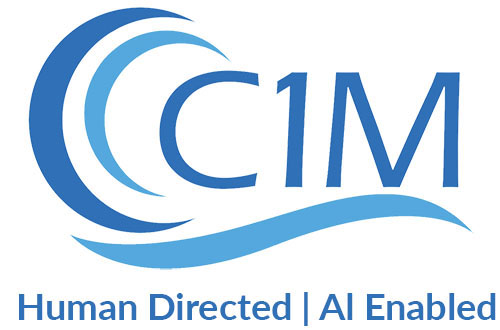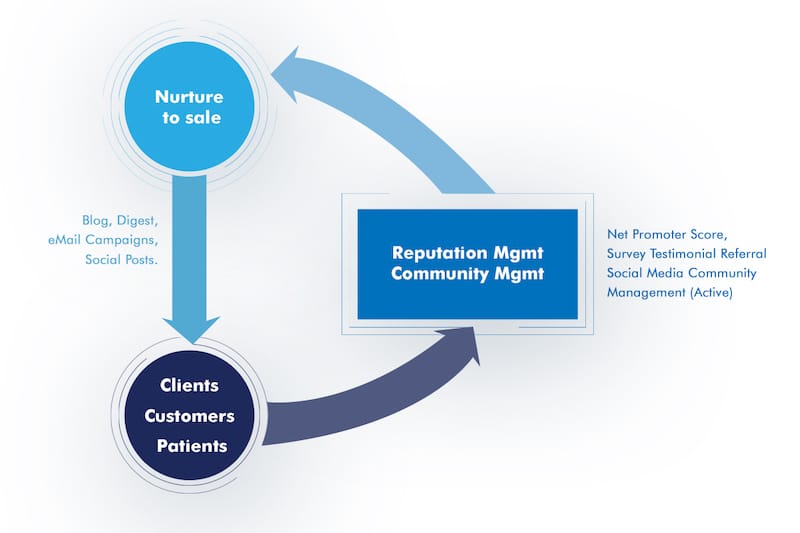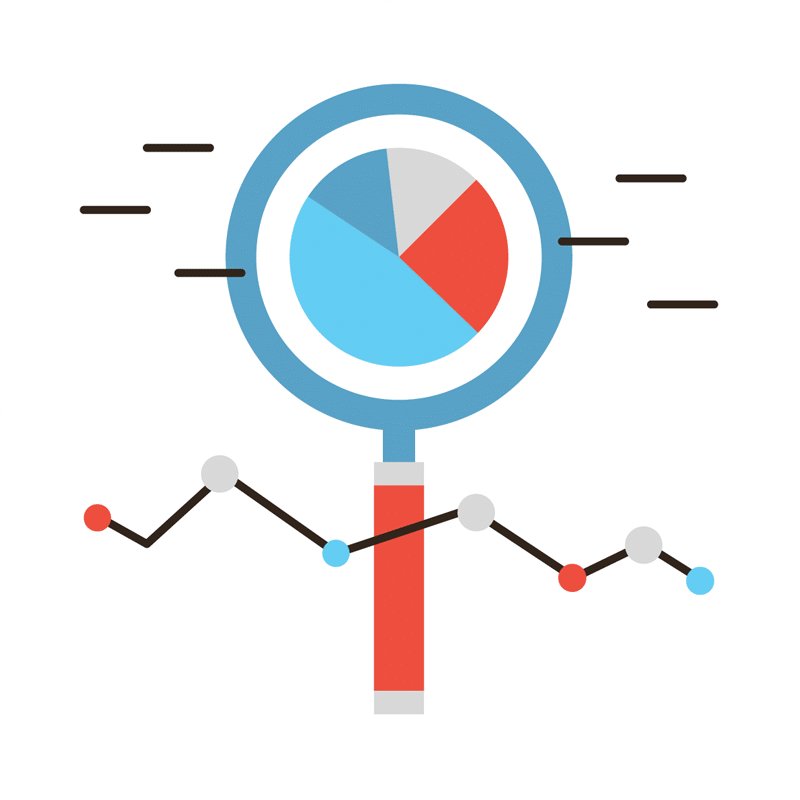
If you own one of the millions of small businesses in the US, you want it to grow and thrive. After all, you didn’t just create your business to be all about the bottom line. You believe in what you’re offering to your customers, and you’re passionate about your work. And you know marketing is key to increasing your sales and reaching the customers who will love your products. The idea is to consistently market your business to your target customer base.
But where to start?
In today’s world, a small business owner has so many options and so many conflicting sources of advice, so it can be hard to cut through the noise and focus on what’s important. You need the right small business marketing solutions. And now, these solutions are digital.
The source of your strategic marketing information is important too: of course, a social media company will tell you Instagram is the answer to building your accounting business. And a website company will insist a glossy home page is how your landscaping business will acquire new customers. But the real answer is more complex than that.
That’s because small business digital marketing is a wide field. And your plan needs to be targeted to your business and your audience – every small business is different.
But all good digital marketing solutions have six key steps in common. If you follow these and think deeply about what each step looks like for your own business, you’re well on your way to growth and success.
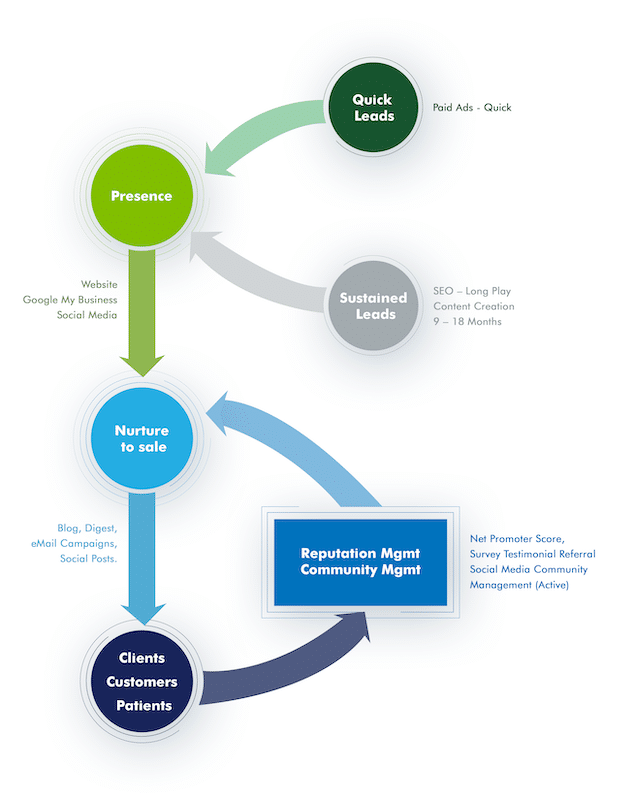 Let’s get into the six steps to grow and market your business.
Let’s get into the six steps to grow and market your business.
1. Presence: Three Things to Market Your Business
No matter what kind of small business you own, you need some form of online presence. Even if you’re a physical business, like a local tire sales company, customers have to be able to find you online when they’re in their driveway, staring at the deflated tire on their Toyota and frantically googling “tire repair near me”. Online search is the new Yellow Pages. And without an online presence, you won’t be able to reap the many benefits of digital marketing.
That being said, here are the three things your small business must have to grow:
-
A clean, professional website
This is your digital storefront. You wouldn’t expect customers to stay long in a dusty, dimly lit, messy shop, so the same goes for your online presence. Your website might be the first thing they find about you. Here are 5 things your web page must-have.
-
Customer reviews
Customers also search frequently for online reviews, so it’s important to have some sort of review page set up. This could be a Google My Business account, which is best for brick-and-mortar businesses. Or it could be a custom paid tool if you’re a firm that operates without a physical location (like a mobile catering business). But having this set up is worth the small investment in time it will take to make sure you’re easy to find for your potential clients.
-
Active social media
You also need to make sure you’re active and visible on the social media platform that makes the most sense for you. Choose LinkedIn for professional services, Instagram for anything visually-based, and Facebook for most consumer-focused businesses. Don’t forget the more niche ones like Yelp, Houzz, and Angie’s List.
Be sure to find your social media voice – first, who are your customers and how do you want to talk to them? A strong social presence isn’t just for the big companies anymore. Local digital marketing is just as important so potential clients in your area can find you and know what you offer.
2. Quick Leads: Market Your Business Fast, But at a Cost
Many of the benefits of digital marketing can take a while to be felt on your business’s bottom line. So if you’re looking to get some clients or customers now because your business has bills to pay, you’ll want to invest in getting some quick leads. These are fast-acting but they’re effective because you pay for them – no freebies here.
There are three main kinds of quick leads your business could use as part of your digital marketing plan:
-
Paid search ads
Paid ads like Google ads can be a great fit if you sell a product that customers frequently search for. That way, you’ll show up quickly at the top of search pages even if your website is brand-new. Paid search ads work best for businesses where customer intent is really important – they’re already looking for what you’re selling. You’re not convincing them they need the general product or service, just to choose yours over the next one.
-
Paid social ads
An alternative is paid social ads – basically getting your product in front of prospects who aren’t searching for you but might like what you have to offer. With paid social ads (usually ads on Facebook or Instagram), you’re looking to increase your brand awareness to a targeted audience.
One of ContentFirst Marketing’s clients, Complete LandSculpture, saw a big increase in their business despite having a brand-new website by investing in thoughtful paid Facebook ads targeting their market.
To maximize effectiveness, you can combine paid search ads with paid social ads (read more details about it here). A prospect searches for a product like yours and is interested enough to click through to your site from a paid search ad, but doesn’t immediately make a purchase. Later, when the prospect is on Facebook or Instagram, and ads pops up reminding them of their interest in your product and keeping your product top-of-mind.
-
Paid display ads
Finally, paid display ads like the banners on the tops or sides of websites can also be a source of quick leads. Don’t just do those without investing in paid search or paid social though, as they’re an accessory to those methods, not a good stand-alone.
So if quick business is what you’re after, paid ads, paid social, and paid display are proven routes to a quick boost in sales. This fast approach is one of the many benefits of digital marketing.
3. Sustained Leads: Playing The Long Game For Long-Term Growth
To grow your business long-term though, you need a sustained digital marketing strategy. Quick leads will only get you so far, and they’ll cost you a pretty penny along the way. That cost means they’re not an ideal long-term growth strategy.
To build steady growth for the future, you should invest your time into building sustained leads. This means building your website as a respected online presence. And it entails boosting your search rating so your website (not just your ads) appears on the first page of Google or Bing results. It also involves growing your social channels so you have lots of organic social media followers instead of just paid ads. You want to be seen as a trusted expert in your field.
How can you make this happen?
By creating excellent targeted content on your site consistently, which raises your SEO ranking (search engine optimization) naturally. This doesn’t mean the old-school way of just shoving loads of keywords into articles, but rather writing for people, not machines. Google’s algorithm has gotten much more sophisticated and now prioritizes articles on which people spend time reading. So you want to make sure your content fits the bill.
How We Help
If you need help with this, ContentFirst Marketing is a respected and effective expert at creating real and compelling content (that’s why it’s in our name, after all!). We’re a digital marketing agency for small businesses like yours. We’ll create a customized plan for your business, making sure your new content fits your style, your needs, and your budget.
ContentFirst Marketing’s client EvexiPEL is proof of this basic concept. They built a brand-new website, and in just nine months, they’ve been getting large and regular increases in traffic just from consistently creating and sharing really strong and thoughtful content.
This is a long-term strategy – it can take 9-18 months to see results when you’re starting from a brand new site. That’s why patience is an important part of this step. But it will position you for long-term solid growth because it comes from being seen as an expert in your field and from a strong, authentic connection with your clients and customers.
A digital marketing company for small businesses like ContentFirst will help you position your brand as a leader in your industry and as a trusted source customers return to over and over again.
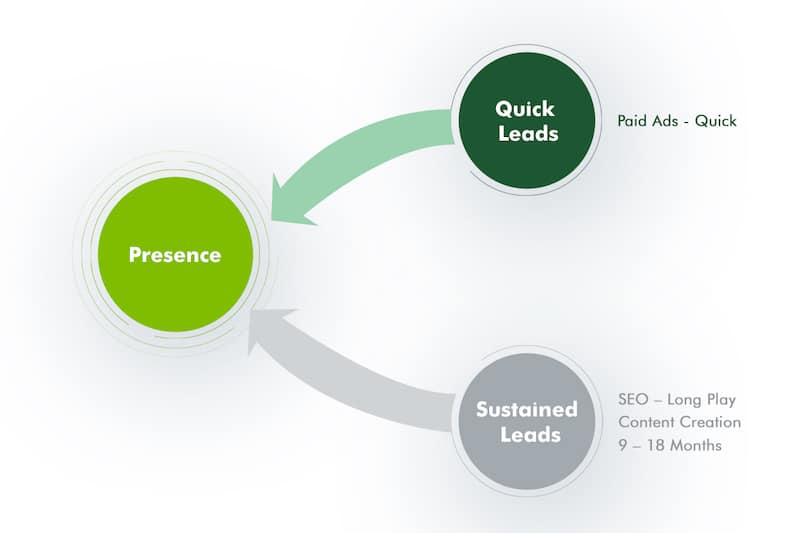
4. Nurture to Sale: Consistent And Steady Wins The Race
So now you’ve reached the exciting part – the sales portion!
Your online presence is up and running and beautifully thought through, your content strategy is in place, and you’re ready to sell.
But it’s not quite that quick – you need to nurture your potential customers until a sale is made. This is because prospects don’t always buy the first time or even the fourth time. They see you – they get distracted by their dog pawing at the door, ponder checking somewhere else, or think “maybe at my next paycheck” and forget to return. So nurturing is key to keeping your brand as the authority in your space in the eyes of those prospects consistently over time.
How can you do this?
Your sustained lead strategy plays a big part in this process. However it is that you’re creating your content (blog, social media, or both) – it all keeps your prospects engaged and interested if you’re doing it right.
And here’s where the next phase comes in. How are those prospects getting this content?
You need to make sure you have a way of reminding them of you regularly. You might be targeting across the whole country for your technology consulting firm. Or, you might be doing some local digital marketing for your sushi restaurant. However you are nurturing prospects, continued brand awareness keeps them thinking of you.
The Importance Of Email
Email marketing is a critical channel to nurture your prospects. Here at ContentFirst, we often advise our clients to start with a series of 5-7 emails when a prospect first shows interest. These aren’t just sales emails – they re-introduce your company, and then go on to speak to certain segments of your audience with specific emails that point to blog posts.
For example, if you’re a medical specialist group, you might have one email that talks about holistic wellness, then one about aesthetic procedures, and finally one about chronic disease treatment. Then as these go out, you can see which customers click onto those related blog posts, and you get a stronger idea of their interests. This is a great start – you can contact them now with information and products you know they’re intrigued by based on their past behavior.
But you can’t stop there.
All that great SEO-friendly content you’re putting out regularly on your blog? Make sure it doesn’t get lost in the noisy world of the web. Send a regular digest email to your online list with your latest 3-5 blog posts – you can send this weekly, monthly, or whatever works with your posting schedule. Your email list might not open every single digest, but they’ll see you in their inbox and remember you and your products and services. This is like a billboard on the highway you pass every day on your commute to work – there in the background even when you’re just driving along thinking about what to have for dinner. But it keeps your brand awareness subtly top of mind for your prospective customers.
Share Away On Social
You also need to be sure to push those blog posts or articles to the relevant social media channels. This is another non-invasive way you stay connected with your prospects, nurturing that relationship until they’re ready to become a customer.
One big success story from ContentFirst Marketing’s clients is Michelle Prince, a motivational speaker and best-selling author. She sells out every Book Bound workshop she holds at ever-increasing numbers. And she does it by diligently collecting email addresses and continuing to drive thoughtful email campaigns regularly. Her clients and prospects feel they get to know her and what she has to offer. By the time she runs a workshop, they’re ready to join and are already convinced of the value she’s offering.
Do all of this right and you’ll find continuous conversions to inquiries and then to those all-important sales.
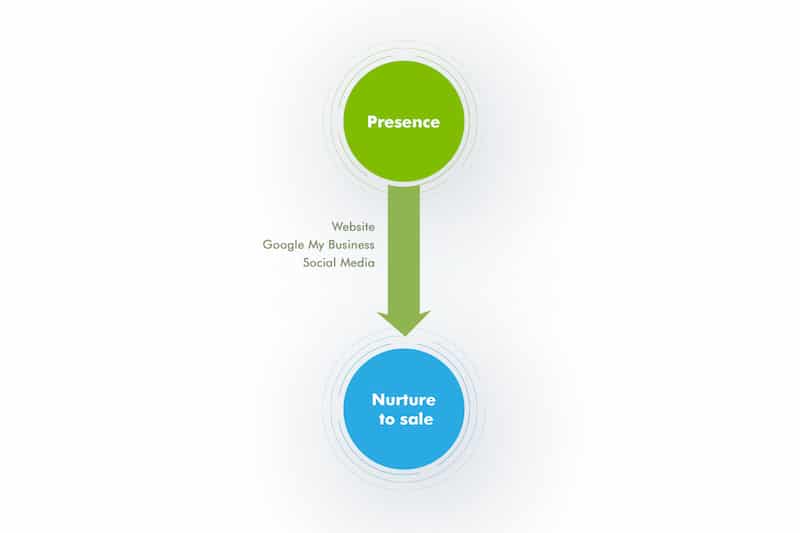
But don’t stop there! A one-time sale isn’t enough.
For continuous growth over the years to come, there are a few more steps. And thinking about your long-term strategy is what will separate you from your competitors. The true benefits of digital marketing come from building long-term relationships with your customers, and these are critical to your continued success as a company.
So you know it’s important. But how do you do it?
You begin the final phases: managing your online reputation and your social community.
5. Reputation Management: The Power Of Word Of Mouth
In our digital world, your reputation is everything. A couple of bad reviews of your ice cream shop on Yelp, of your beauty salon on Google or your consultant firm on Facebook can warn off new and old customers alike. So you want to be proactive about getting the good reviews out there, and they won’t always appear on their own without any action from you. Think about it – are you more likely to go to the trouble of leaving an online review without prompting if you have a good experience or a bad one?
So if you want to encourage your customers to leave you a glowing review, here are your key steps.
Send surveys
First, make sure you’re sending customers a feedback survey after a completed sale or transaction. We love the Net Promoter Scoresystem because the question is simple – on a scale from 1-10, how likely are you to recommend us to your friends and family? Once you’ve received those scores, sort through and see if there are patterns in the Detractor category you can address.
Follow up
Next, for the Promoters (anyone who rates you a 9 or 10), send a follow-up email asking them to leave you a review on your site of choice: TripAdvisor for travel and hospitality, LinkedIn for professional services, Yelp for certain businesses, etc. You don’t want to ask those who give you a 2, because those aren’t the reviews you want to encourage. It’s crucial to be diligent about asking every single Promoter to leave you a review because usually, only about 5% of them will follow through. But those glowing reviews, if you accumulate enough of them, will steadily boost your reputation online and translate to even more sales.
Reach out to the Promoters
Twice a year, you should also email those Promoters. After thanking them for their business and support, remind them that your business is built on referrals from people like them, and ask them to refer you to a friend. This isn’t just about getting a referral, though those are always a welcome bonus. It also serves to remind them they had a great experience with you, and might even prompt them to make another purchase. An all-around win-win if you ask us.
6. Social Media Management: Creating Authentic Engagement
As your online presence matures, thanks to your thoughtful hard work on the items above, you move from just posting content to managing a community on social media. This comes when you’ve avoided making these social media marketing mistakes, and is an increasingly important component of staying engaged with your current and potential customers.
Keep customers engaged while keeping a good reputation
This stage is about more than just trying to promote your business and creating general brand awareness. You need to engage your customers and your social media community. Ask questions, do surveys, share your customers’ photos and thoughts, do giveaways – whatever is most likely to keep your audience authentically engaged.
You want to be seen as a respected leader in your field, as a trusted and real brand, as an exciting and engaging company who’s not afraid to get out there and be seen. This keeps your customers and prospects coming back to your social media or your website, keeping you in their minds as they go about their lives. With the amount of time most of us spend on social media these days, time spent on community management (or even the cost of dedicating a resource to spend time on it for you) is an investment with the potential for some big returns.
This long-term exposure all ties back into the nurture campaign as well – getting them primed to think well of you and your products while you nurture that relationship into an eventual sale, and from there into a long-term customer relationship. If you do this right, your customers will return again and again, back into the nurture funnel repeatedly without expensive ad campaigns. They come back because they feel genuinely connected to you, to your brand, and to what you’re selling.
Digital Marketing Life Cycle: Stronger Business Growth Long-term
All of these steps are part of small cycles – the presence and the leads as one, the nurture and the management as another. Ticking off a few linear steps can be great for getting one-off business (those paid ads might get you one purchase from a few customers), but building your business over the long-term means thinking strategically and over a few years, not a few months. You can hire a digital marketing company like ContentFirst Marketing to help you with your marketing efforts, of course. But with the right tools we’ve given you above, you can also craft a plan with a little thoughtful work.
After all, you built this business because you care about what you do and what you provide to your customers, not just about the bottom line. Your digital marketing strategy should reflect that care and that passion, and create a way for your business to thrive for many years to come.
Where to Start?
The most effective digital marketing strategy is one that is comprehensive. It takes into account emerging trends and engages a number of different channels. It uses available data to inform its marketing tactics and offer its product or service to a large targeted audience. In turn, a company will see increased brand awareness, more qualified leads, and more customer engagement.
With consumers spending more and more of their time engaging with the digital world, there are few better things for a company to invest in.
Don’t have time to think through your digital marketing plan? Let us help. Schedule a free business growth call here to discuss how to jump start consistent growth.
